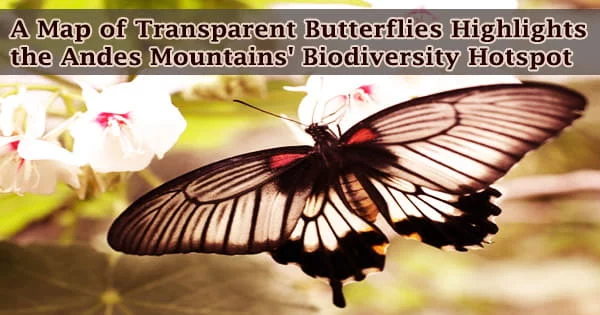Insects are by far the most varied group of organisms on the planet, with conservative estimates estimating that there are millions more waiting to be discovered. However, human-caused extinction may be exceeding the rate of discovery, with species going extinct before researchers even realized they existed.
Scientists must first determine the location of these species in order to conserve them. While the distributions of several plant and animal species have been carefully documented, the location of the world’s insects is still unknown.
Researchers in a recent study generated the most detailed distribution map of butterflies in the American tropics to date, revealing that locations with the most diversity are also those most threatened by deforestation and industrialization.
The study focused on Ithomiini, or glasswing butterflies, a vast family of roughly 400 species found across much of Central and South America. Because of their widespread distribution, they may serve as an excellent predictor of the fate of other insects in the area.
“If we want to understand the diversity of insects in general, then one approach is to concentrate on groups that likely reflect the diversity of all insects and for which we have good knowledge, like butterflies,” said study co-author Keith Willmott, curator, and director of the Florida Museum of Natural History’s McGuire Center for Lepidoptera and Biodiversity.
Mimicry both helps and hinders glasswings
The distinctive, transparent wings of glasswing butterflies are marked with brilliant dots of alternating hues and patterns, earning them the name. These markings, like those of many other butterfly species, such as monarchs, act as a warning.
Male glasswing butterflies feed on poisonous plant nectar and tissue, accumulating toxins in their abdomen and passing them on the females during mating. These toxins, which are a form of alkaloid, have a bitter taste that renders the butterflies and their eggs undesirable.
At the moment, loss of habitat is the most significant threat. It is just an unfortunate coincidence that areas that are good for people to live are also areas that support high animal and plant diversity.
Keith Willmott
But would-be predators don’t know not to eat these butterflies from birth; instead, they learn via trial and error. As a result, numerous glasswing species have evolved identical wing patterns, giving them a numerical advantage.
“Since different species share the same warning color patterns, they share the overall cost per species of educating predators to avoid them,” Willmott said.
Müllerian mimicry, a sort of likeness, has allowed glasswing butterflies to survive and diversify in the tropics’ diverse habitats, but it comes at a cost. While this method works well when all species that look alike are thriving, Willmott cautioned that the extinction of one species could risk the existence of others.
“This is particularly true if one of the more common species goes extinct because all the others lose the benefit they gained from being involved in Müllerian mimicry with those butterflies.”
Glasswing butterflies are most diverse and most vulnerable at high elevations
Willmott and his colleagues have spent decades searching for glasswings in mountains and woods, discovering new species, and recording their natural history in the process.
The researchers produced over 30,000 distribution records by merging data gathered over the years with information acquired from specimens in more than 60 institutions and private collections.
They mapped the variety of glasswings and interactions between lookalike species across the American tropics using this massive dataset. Their findings show that glasswings are very diverse in some areas of their distribution, such as the Amazon River region, where their transparent wings help them blend in with the forest’s gloom.
However, in mountainous biodiversity hotspots, the bulk of species congregate. The top 5% of glasswing diversity was found on the eastern slopes of the Andes Mountains, with secondary hotspots in Central America’s highlands and Brazil’s Atlantic coastal forest.
Glasswing diversity in the tropical Andes typically corresponded with places at the highest risk of habitat loss due to land conversion for agriculture, whereas enormous swaths of the Amazon rainforest remain relatively untouched. This was especially true for species with limited distributions, emphasizing the need of conservation efforts in these locations.
As they rise in elevation, mountainous regions create a range of small, localized ecosystems. The Andes, which are among the world’s highest mountains, supports a huge number of species because to their youth. The Andes are also a good site to cultivate a variety of crops due to the changes in topography, temperature, and rainfall.
“At the moment, loss of habitat is the most significant threat,” Willmott said. “It is just an unfortunate coincidence that areas that are good for people to live are also areas that support high animal and plant diversity.”
Maël Doré, the study’s lead author and a doctorate student at the National Museum of Natural History in Paris, is concerned that climate change could further restrict the range of already-restricted species on tropical mountain slopes.
As temperatures rise, species may adapt by moving their distributions to higher elevations, but it’s unclear if glasswing populations will adapt quickly enough to keep up with climate change.
Far from the Andes, a number of rare and endemic glasswing species live in the lower and older mountains along the Brazilian Atlantic coast, which are similarly threatened by habitat destruction.
“This region has experienced almost five centuries of human occupation, but it was also here that pioneering initiatives to protect Neotropical butterflies and their habitats were born almost 100 years ago,” said co-author André Freitas, a professor at the Universidade de Campinas in São Paulo, Brazil.
Willmott and his colleagues, on the other hand, are upbeat. Conservation efforts can be directed to settings and communities that are under threat, as well as those that are still unspoiled by humans, using a thorough map of butterfly distribution.
“With more accurate maps of butterfly distributions, we can identify species and communities that currently lack protection, to more effectively focus limited resources where they are most needed,” Willmott said.





